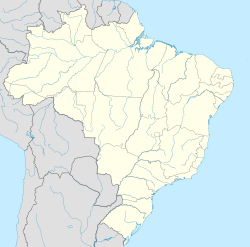
Rio de Janeiro, or simply Rio, is the capital of the state of Rio de Janeiro. It is the second-most-populous city in Brazil and the sixth-most-populous city in the Americas.
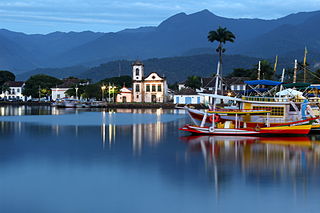
Paraty is a preserved Portuguese colonial (1500–1822) and Brazilian Imperial (1822–1889) municipality with a population of about 43,000. The name "Paraty" originates from the local Guaianá Indians' indigenous Tupi language, named for an abundant local fish native to the region. Paraty is located on the Costa Verde, a lush green corridor that runs along the coastline of the state of Rio de Janeiro, in Brazil. Paraty has become a tourist destination, known for its historic town center and the coast and mountains in the region. The historic center of the city, as well as four areas of the Atlantic Forest, were inscribed on the UNESCO World Heritage List in 2019 under the title "Paraty and Ilha Grande".

Afro-Brazilians are an ethno-racial group consisting of Brazilians with predominantly or total Sub-Saharan African ancestry, these stand out for having dark skin. Most multiracial Brazilians also have a range of degree of African ancestry. Brazilians whose African features are more evident are generally seen by others as Blacks and may identify themselves as such, while the ones with less noticeable African features may not be seen as such. However, Brazilians rarely use the term "Afro-Brazilian" as a term of ethnic identity and never in informal discourse.

The Carnival of Brazil is an annual festival held the Friday afternoon before Ash Wednesday at noon, which marks the beginning of Lent, the forty-day period before Easter. During Lent, Roman Catholics and some other Christians traditionally abstained from the consumption of meat and poultry, hence the term "carnival", from carnelevare, "to remove meat."
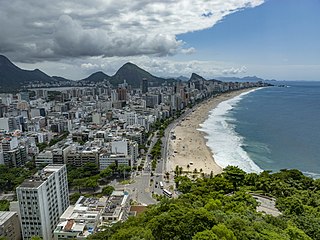
Leblon is a neighborhood of Rio de Janeiro, Brazil. It is also the name of the local beach. The neighborhood is located in the South Zone of the city, between Lagoa Rodrigo de Freitas, Morro Dois Irmãos and the Jardim de Alah channel, bordering the Gávea, Ipanema, Lagoa, and Vidigal neighborhoods. It is regarded as a very affluent area.

São Cristóvão is a Brazilian municipality in the Northeastern state of Sergipe. Founded at the mouth of the Vaza-Barris River on January 1, 1590, the municipality is the fourth oldest settlement in Brazil. São Cristóvão is noted for its historic city square, São Francisco Square, and numerous early colonial-period buildings. The 3 hectares site was designated a UNESCO World Heritage Site in 2010.

Luiz Pacheco Drummond, nicknamed Luizinho Drummond, was an illegal lottery operator (bicheiro) and the patron of samba school Imperatriz Leopoldinense. He was the president of the Independent League of Samba Schools of Rio de Janeiro (LIESA) from 1998 to 2001. He was born and died in Rio de Janeiro.

The Portuguese royal court transferred from Lisbon to the Portuguese colony of Brazil in a strategic retreat of Queen Maria I of Portugal, prince regent John, the Braganza royal family, its court, and senior officials, totaling nearly 10,000 people, on 27 November 1807. The embarkment took place on 27 November, but due to weather conditions, the ships were only able to depart on 29 November. The Braganza royal family departed for Brazil just days before Napoleonic forces invaded Portugal on 1 December 1807. The Portuguese crown remained in Brazil from 1808 until the Liberal Revolution of 1820 led to the return of John VI of Portugal on 26 April 1821.
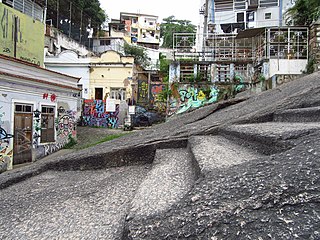
Pedra do Sal is a historic and religious site in Rio de Janeiro, in the neighborhood of Saúde. The site was originally a quilombo village. An association group still lives there, formally known as the Community Descendents of the Quilombos of Pedra do Sal. The site was recognised in 1984 by INEPAC, the Institute for State Cultural Heritage.
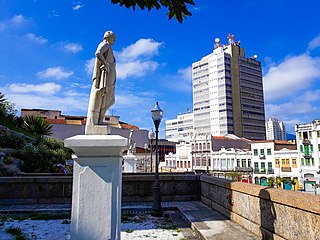
Saúde is a neighborhood of Rio de Janeiro, Brazil. Its population in 2000 was 2186. Located on the coast, just north of the historical centre in downtown Rio, west of Praça Maua and east of Gamboa, Rio de Janeiro, it contains several notable hospitals such as Hospital dos Servidores de Estado and Hospital Pro Matre; the name Saúde means "Health" in Portuguese. It is marked by many homes for the lower middle class and numerous sheds, warehouses and depots are located in the region.
The following is a timeline of the history of the city of Rio de Janeiro, Brazil.
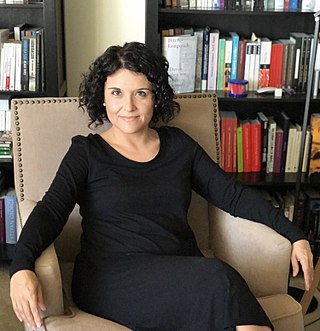
Ana Lucia Araujo is an American historian, art historian, author, and professor of history at Howard University. She is a member of the International Scientific Committee of the UNESCO Slave Route Project. Her scholarship focuses on the transnational history, public memory, visual culture, and heritage of slavery and the Atlantic slave trade.

The Atlantic slave trade to Brazil occurred during the period of history in which there was a forced migration of Africans to Brazil for the purpose of slavery. It lasted from the mid-sixteenth century until the mid-nineteenth century. During the trade, more than three million Africans were transported across the Atlantic and sold into slavery. It was divided into four phases: The cycle of Guinea ; the cycle of Angola which trafficked people from Bakongo, Mbundu, Benguela, and Ovambo; cycle of Costa da Mina, now renamed Cycle of Benin and Dahomey, which trafficked people from Yoruba, Ewe, Minas, Hausa, Nupe, and Borno; and the illegal trafficking period, which was suppressed by the United Kingdom (1815–1851). During this period, to escape the supervision of British ships enforcing an anti-slavery blockade, Brazilian slave traders began to seek alternative routes to the routes of the West African coast, turning to Mozambique.
Beatriz Francisca de Assis Brandão was a Neoclassical or Arcadian Brazilian poet, translator, musician, educator and early feminist. One of the few prominent female intellectuals and artists in Brazil during the reign of Pedro II, she became well-known for her poetry, frequently published in Brazilian newspapers. Through her life and work, she challenged the dominant societal roles for women at the time and played an important part in Brazilian social, political and cultural history.
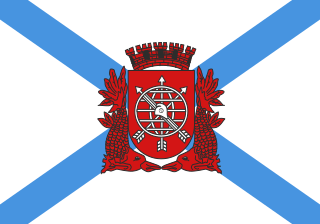
The following outline is provided as an overview of and topical guide to Rio de Janeiro:

Eusébio de Queirós Coutinho Matoso da Câmara was a Brazilian magistrate and politician, Minister of Justice (1848–1852) and author of one of the most important laws of the Empire of Brazil, the Eusébio de Queirós Law, which suppressed the slave trade and paved the way for its eventual eradication. He was also responsible for the Commercial Code of 1850 that still remains partly in force today.

Nos Tempos do Imperador is a Brazilian telenovela produced and broadcast by TV Globo. It aired from 9 August 2021 to 4 February 2022. The telenovela is written by Thereza Falcão and Alessandro Marson, with the collaboration of Duba Elia, Júlio Fischer, Lalo Homrich, Mônica Sanches and Wendell Bendelack.

D. Marcos de Noronha e Brito, 8th Count of Arcos was a Portuguese nobleman and colonial administrator who served as the last Viceroy of Brazil. He ruled from 21 August 1806 to 22 January 1808, when John VI of Portugal, then Prince Regent of Portugal, arrived in the city of Salvador, transferring the seat of the monarchy to Brazil.
Eliana Alves dos Santos Cruz is a Brazilian journalist and writer.

